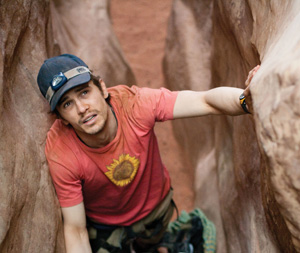Movies
127 Hours
 NO WAY OUT: James Franco gets wedged too tight for comfort in '127 Hours.'
NO WAY OUT: James Franco gets wedged too tight for comfort in '127 Hours.'
THIS IS the kind of thriller that feels so good when it stops. Might it feel even better if it didn't start in the first place? 127 Hours is Danny Boyle's version of the true-life story of climber Aron Ralston. In spring 2003, Ralston was pinioned under a half-ton boulder in a remote Utah canyon; what he did to survive became worldwide news.
Those who have heard of the story (and essentially prayed that they would never make a movie out of it—or that Werner Herzog would direct if it absolutely had to be done) will be teased early on. As Aron (James Franco) packs for the fateful trip, we see his face from the inside of a cupboard, where a Swiss army knife lies waiting.
127 Hours records an ordeal so singular, Poe couldn't improve on it. Unfortunately, director Danny Boyle (Slumdog Millionaire) tries to blow up the story's elemental horror through pyrotechnics. The title sequence shows the crowded world, driving, praying, rushing—all at once on triple-screen. Aron is running away from this hectic existence: first driving through the night in his truck into the desert and then speeding on his mountain bike over the hills.
Boyle starts with a burst of relentless motion, as in his Trainspotting. Unfortunately, this ADD style has been thoroughly appropriated for sports-drink commercials. (The products more or less advertised in 127 Hours are Gatorade and Coors, likely appropriate in a story of a man perishing of thirst.)
Ralston isn't an ordinary Joe; reporter Scott Willoughby notes that he had climbed 49 of Colorado's 14,000-foot-plus peaks. Franco plays him as a het-up kid, a showman, with a digital camera recording his thoughts and acting as chorus. At times, Aron imagines himself as a guest on a hallucinatory TV show, as if forecasting the real-life Ralston's later fame as the subject of a major motion picture.
The camera plays back visions of the life that he's likely to lose, and the battery never seems to give up. There are other video-game essentials; a digital thermometer onscreen recording the drop in the temperature.
The film is the work of someone terrified of boring the audience by making the walls close in on them. And yet all this relentless flash—the camera even snakes up inside the tube of a camelback water carrier—can't illuminate something that was essentially a terrible incident. Instead, it finds a moral lesson: Aron should have connected with the multitude, with his plaintive mom, whose calls he never returned, as well as with the girlfriend who dumped him for his breeziness.
Clémence Poésy plays the girl, and she's an oasis in this picture, a vision of downy flesh in a movie that's loaded with tight close-ups of a man expiring slowly. Her parting line, "You're going to be so alone, Aron," underscores a weak idea: the cave ordeal as a kind of payback for someone young and disengaged. You can see how Boyle has changed since the misanthropy of Shallow Grave, where hell was other people. Franco's visceral acting in the service of this horror story probably should be praised, even if it's not a pleasure to watch. One would have to be fairly simple-minded to think of this ghastly story as some kind of triumph of the human spirit.
127 Hours should be effective to anyone not numbed by disgust, but I was just that numbed by Boyle's attempt to scratch up a narrative. The details—like an ant's mandible pinching Aron's face—mirror the sense that Boyle had ants in his pants, that he was without enough calm to make visions of a home life look homey, or a lover look compassionate, or a desert look serene. Watching 127 Hours, I ended up trapped myself: trapped between the longing to see Aron just get it over with, and the longing to not to see it happen.
R; 94 min.


